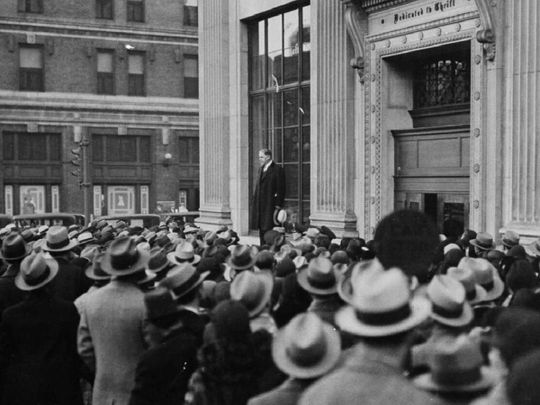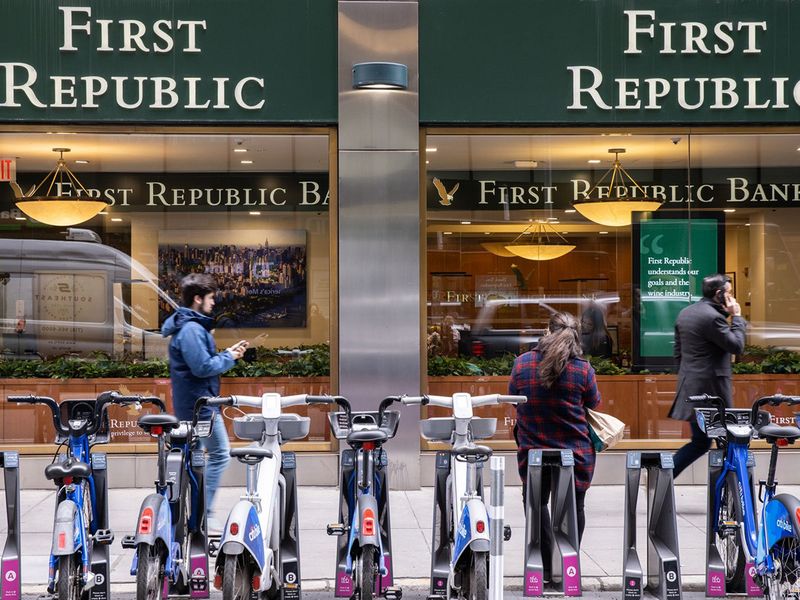
Highlights
- It’s never easy to predict when a bank will collapse — until it happens.
- “Bank runs”, the massive withdrawal of deposits by customers usually preceding a bank failure, are not uncommon.
Dubai: Earlier this week, Silvergate Capital and Silicon Valley Bank (SVB) collapsed, in the biggest bank failures since 2008. The collapse of New York’s Signature Bank came a few days earlier (March 8, 2023).
Their names are easy to remember: they all start with “Si”.
One knock-on effect: Investors dumped US bank stocks. As share prices plunge across the banking industry (i.e. First Republic Bank’s share plummeted 74% following the Silicon Valley Bank collapse), global banks braced for contagion.
One possible scenario is that if the market rout does not see the bottom, other regional US banks may be forced to seek “saviours”, say industry executives.
During America’s 246-year history, literally thousands of banks have failed beyond salvation, events that led to reforms and safeguards to prevent similar events from occuring.
A quick historical background check shows that in just one episode of “bank runs” that led to bank collapse, in the first 10 months of the “Great Depression”, 744 US banks were wiped out.

During 1933 alone, about 4,000 US banks failed, according to Investopedia, a New York financial site.
9,000
number of US banks that failed in the 1930s in the midst and following 'the Great Depression'
In total, a whopping 9,000 US banks faced insolvency in the 1930s — when an estimated $140 billion in depositors’ money vanished in thin air.
This could occur because the bank concerned has become “insolvent” (unable to pay debts owed) — or because it no longer has enough liquid assets (cash) to fulfill its payment obligations (like withdrawal from depositors).
Why do banks fail?
The reasons vary (we list some below). A common trigger: wrong investment decisions (which lead to excessive losses) on the part of the banks, speculation or systemic weaknesses — as when the economy as a whole is struggling.
In general, a bank is considered to have “collapsed” or “failed” when its asset value drops below the market value of the bank's liabilities —money owed to depositors and creditors.
But there are unforeseen triggers too. For example, in 2020, the first year the pandemic hit, four US banks failed. The year before that, in 2019, four banks also failed.
What are the signs a bank would fall?
It’s hard to predict when a bank will collapse. Before 2008, who could have predicted that Lehman Brothers, founded in 1847, the fourth-largest investment bank in the US then (behind Goldman Sachs, Morgan Stanley, and Merrill Lynch),with 25,000 employees worldwide, would stop operating — 158 years after it was founded? Still, it happens. It turns out that neither age, nor experience, guarantees resilience.

How many banks failed in recent years?
From 2001 to 2008, 25 US banks went under. Between 2008 and 2015, more than 500 US banks failed, according to American Deposit Management, a US financial services company.
What’s the difference between past and present bank failures?
There’s a big difference between past and current bank failures. This is especially true when it comes to the way customers are treated. In the past, when banks fail, their customers’ money also vanish in thin air.
Today, when a bank fails, assuming the Federal Deposit Insurance Corp (FDIC) insures its deposits and finds a bank to take it over, its customers will likely be able to continue using their accounts, debit cards, and online banking tools.
Bank runs usually occur at uninsured "shadow banks" — those that are not part of the FDIC or the US National Credit Union Administration (NCUA).

Is it possible to reclaim uninsured deposits from a failed bank?
It is. But to reclaim uninsured deposits from a failed bank, the process may take months, if not years.
A brief history of US bank failures:
A review of the history of US banking covers the period from the 1819 financial panic to 2023.
1819-1821:
Cause: Financial panic. After Britain and France ended their fighting, the market for American goods collapsed, triggering US bank failures. Also there was excessive speculation in public lands driven by loose government issuing of paper money. The result: Many banks failed.
1837 to mid-1840s:
Cause: Speculation. There was a land price bubble, speculative lending practices in western US states, and rapid decrease in cotton prices. Result: Out of 850 banks then, 343 banks failed; and an additional 62 banks “partially failed".
1873:
Cause: Financial panic. The bankruptcy of a railroad company, Jay Cooke & Co, which started selling railroad bonds in September 1873, led to the 1873 panic.
1907:
Cause: Speculation. Two speculators named F. Charles W. Morse and Augustus Heinze tried to corner the United Copper stock, but they failed and suffered significant losses. Depositors started taking their money out of banks connected to these two men.
1929 to 1930s:
Cause: Stock market crash and “Great Depression”. The "Black Tuesday" stock market fall on October 29, 1929, marked the formal beginning of the Great Depression. Bank runs in the 1930s saw the failure of around 9,000 US banks.
• It was established by the Banking Act of 1933, which was adopted during the Great Depression to restore trust in the American banking sector.
• FDIC's role: It guarantees deposits, audits and supervises financial institutions for safety, soundness, and consumer protection, facilitates the resolution of large and complex financial institutions, and oversees receiverships.
1980s and 1990s:
Cause: Savings and Loan (S&L) crisis. Following the 1970s “stagflation”, S&Ls found themselves at the losing end. Significant profits in 1980 fuelled speculation but and by 1982, S&Ls were losing up to $4 billion annually.
More than 1,000 S&Ls had failed, a trend that persisted into the early 1990s.
2008:
Cause: Economic contagion. Lehman Brothers and Bear Stearns, two investment banks, went bankrupt in March 2008. The trigger: widespread speculation and “liar loans” in the housing markets.
2020:
Cause: COVID-19 pandemic. The exceptional "stimulus” during this time led to significant growth in bank deposits. These factors contributed to the failure of only four banks in 2020 and none in 2021.
2023:
Cause: High interest rates and crypto asset plunge. California’s SVB failed because it held huge amounts of government bonds that plunged in value as the US central bank (Federal Reserve), raised rates.
When the bank announced it was trying to raise money, it sparked a “run” from depositors, and the bank collapsed.
New York’s Signature Bank took deposits of crypto assets in 2018. The collapse of FTX and an ensuing criminal investigation led to a collapse in Signature’s assets.
Silvergate Bank, established in California, eventually folded due to huge losses on asset sales at the end of the previous year, when the bank sold securities at fire sale prices to keep afloat during a bank run. "Short" selling attacks were also thought to have aided in the acceleration of the bank run.











